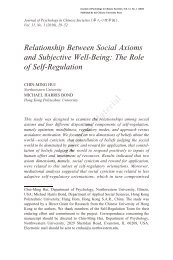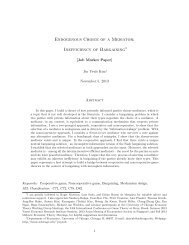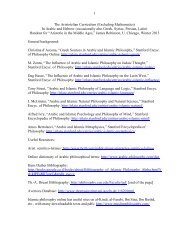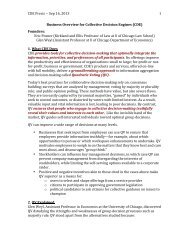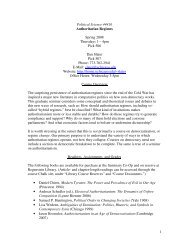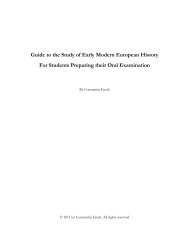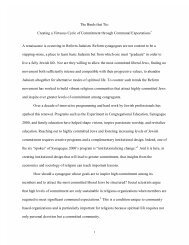Convergence Between Black Immigrants and Black Natives Across ...
Convergence Between Black Immigrants and Black Natives Across ...
Convergence Between Black Immigrants and Black Natives Across ...
You also want an ePaper? Increase the reach of your titles
YUMPU automatically turns print PDFs into web optimized ePapers that Google loves.
<strong>Immigrants</strong>: A black success story?” (Model 1991, 1995, 2008, Butcher 1994, Kalmijn 1997, Waters 1999).<br />
These results raise the possibility of a new question: “African <strong>Immigrants</strong>: The black success story?” 10<br />
Panel B of Table 1 displays the same mean outcomes for women in 2011. At first glance, we can<br />
already see that the variation in outcomes across groups is much less than that of men. Conditional <strong>and</strong><br />
unconditional annual earnings of native black women are at 91% <strong>and</strong> 78% of those of white women, which<br />
points to a much more equal distribution than that of men (64% <strong>and</strong> 48%). The gap in the fraction employed<br />
between whites <strong>and</strong> native blacks falls from 20 percentage points to 5 points. Incarceration probabilities for<br />
females are below 1% for all subgroups but native black women are still two <strong>and</strong> a half times more likely<br />
to be imprisoned than white women. Educational patterns display the same relations as those for men but<br />
the variability is compressed. Differences in marriage probabilities are an exception. White women aged<br />
21-65 are more than twice as likely to be married as native black women (59% <strong>and</strong> 28%), while the black<br />
immigrant female marriage probability lies in between these two rates (45%). 11<br />
3.3 Descriptive Statistics for the Second Generation<br />
Section 3.2 established that black first generation immigrants look very different than black natives. From a<br />
theoretical perspective it is unclear what will happen to the second generation since there are two opposing<br />
forces at work. First, the parents of second generation blacks are relatively successful, which would point<br />
towards positive outcomes. Second, the economic outcomes of black natives, whom the second generation<br />
might identify with, have stagnated over the past few decades, which would suggest negative assimilation.<br />
Table 2 compares education <strong>and</strong> earnings outcomes of both generations for working age men. Due<br />
to small sample sizes in the CPS, observations are pooled over the 5-year period from 2008-2012. At<br />
first glance, it seems that earnings <strong>and</strong> employment outcomes of second generation black men are low <strong>and</strong><br />
comparable to those of native blacks (Panel A). Note, however, that the average second generation black is<br />
more than 8 years younger than the first generation immigrant. Since earnings increase steeply until the mid<br />
forties, column 5 uses inverse probability weighting to equalize the age distribution of the first <strong>and</strong> second<br />
generation. Now sons of black immigrants earn $3000 or 8% more than the average first generation black<br />
immigrant. 12 The fraction of second generation blacks with a college degree is 35% or 4 percentage points<br />
higher than those of the first generation. In terms of marriage patterns, however, the second generation seems<br />
to be converging to native blacks, rather than the first generation. While 60% of the black men in the first<br />
generation are married, only about 43% of both natives <strong>and</strong> sons of immigrants are are married. This points<br />
to different integration patterns between labor market <strong>and</strong> marriage market outcomes.<br />
10 There are several reasons to be cautious about these results <strong>and</strong> they certainly require further investigation. First, many African<br />
immigrants come to the US to attend college or graduate school so they are a very select group. This is not a problem with my hypothesis<br />
per se since self-selectivity of immigrants is part of the reason black-white gaps are underestimated. Second, immigrants that do not<br />
become naturalized are likely to be deported for severe crimes. Hence we would expect immigrants’ incarceration probabilities to be<br />
lower even if their probability of being convicted of a crime that would lead to incarceration were identical.<br />
11 See Charles <strong>and</strong> Luoh (2011) for a link between increased male incarceration rates <strong>and</strong> decreased female marriage rates.<br />
12 The second generation premium equals 5% for white <strong>and</strong> Asian men <strong>and</strong> a striking 35% for Hispanic men.<br />
6





